#Utagawa Kunisada
Text
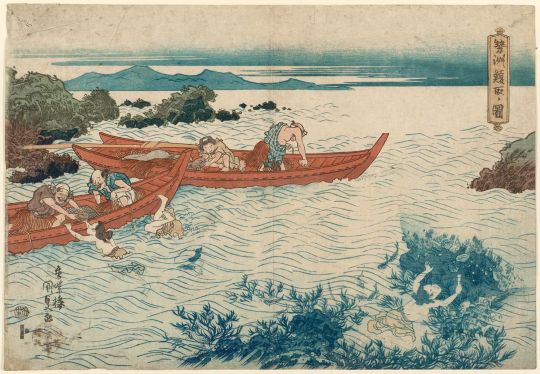
Utagawa Kunisada, Abalone Divers, 1832
221 notes
·
View notes
Text


Utagawa Kunisada, Red Maple Leaves at Tsūtenkyō Bridge (1854)
From Vincent van Gogh's Japanese print collection.
#autumn vibes for you guys even though it's almost spring where i live <3#utagawa kunisada#art#van gogh's japanese print collection
1K notes
·
View notes
Note

Hello! i saw your kimono drawing guide, and i have some questions.
I saw this art and was wondering about a few things:
what is the tied knot& tassel things on the sleeves for?
and, what hairstyle is the lady wearing?
If you know, please tell me!
If you don't know, could it be possible to direct me to someone that might? Thank you for taking the time to answer, if you're able! Have a lovely night/day!
Hi and thank you for your question :) The ukiyoe you are sharing is by Utagawa Kunisada and titled Genji rokujo no hana (源氏六條の花), or "Cherry Blossoms at Genji's Rokujô Mansion". It is part of a three prints set:

It depicts an imaginary scenery from The tale of Genji, and the young lady playing with her pet cat is the princess Onna San no Miya.
Characters are not shown wearing period accurate clothes (from Heian era), but luscious Edo period attires. Because of her rank, the young princess is wearing what Edo princesses would, especially the trademark hairstyle named fukiya 吹輪.
You'll find below a translation from a costume photobook I did a while ago. Note the big bridge style front hairpin, and the drum like one in the back. Princesses from the buke (samurai class) would also have dangling locks called aikyôge (I also found the term okurege), but I am not sure kuge princesses (noble class) wore them too.

There is a whole dispute about this hairstyle, as we are not actually sure it was worn as such by actual princesses. This style may have in fact started as a somehow cliché bunraku/kabuki costume used to depict princesses (think a bit like Western Cinderella-types princess gowns). Nowadays, it is found only as a theater style, or worn by Maiko during Setsubun season.
For comparison, here is character Shizuka Gozen from kabuki play Yoshitsune Senbon Zakura:

As for the dangling cords, I covered those in a past ask about kamuro that you can find here (part 1 / part 2). TL:DR: I am still not sure what is the exact name for those decorations (kazari himo? sode no himo?).
But their use is pretty much linked to 3 things:
1) luck + protection (knots have auspicous meanings),
2) reinforcing weak points of garnment (here: sleeves wrist opening)
3) cuteness impact, as much like furisode (long sleeves kimono) those dangling ribbons were mostly seen on girls/young unmarried ladies by the Edo period
All the design elements chosen by Utagawa Kunisada for his Onna San no Miya stress own young and carefree she is still (which considering her narrative arc is in fact a bit sad... like all Genji Monogatari stories). BUT: bonus points for pet cat!
Hope that helps :)
#japan#kimono#ask#fashion history#art history#ukiyoe#The tale of Genji#genji monogatari#Utagawa Kunisada#hime#princess#onna San no Miya#nihongami#japanese hairstyle#fukiya#katsuyama#kazari himo#sode no himo#dangling ribbon#kamuro#kumihimo#ribbon#cord
484 notes
·
View notes
Text
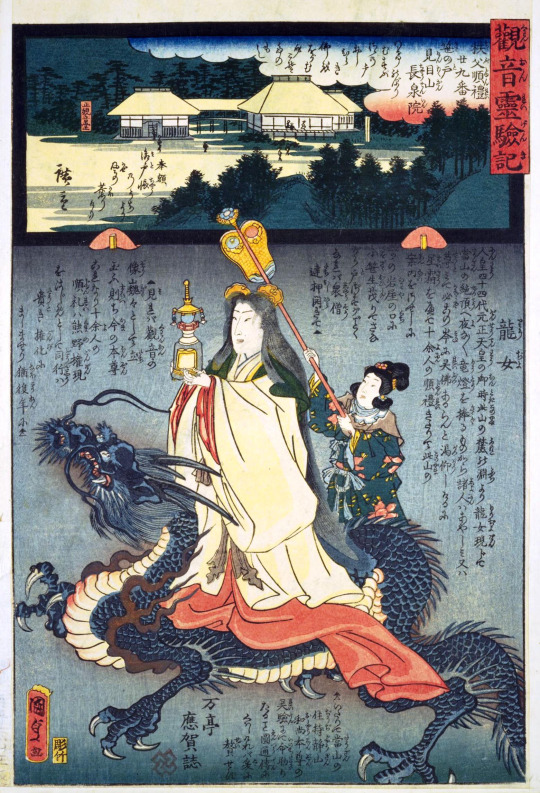
Dragon Woman during the Time of Empress Gensho, Kunisada, 1800
#art#art history#Asian art#Japan#Japanese art#East Asia#East Asian art#ukiyo-e#woodblock print#Kunisada#Utagawa Kunisada#Utagawa School#Edo period#18th century art
250 notes
·
View notes
Photo

Poet and butterfly, published by Otaya Takichi by Utagawa Kunisada (colour woodblock print)
#art#artwork#kunst#kunstwerk#utagawa kunisada#artist#künstler#otaya takichi#person#human being#mensch#poet#dichter#poetry#writing#schreiben#animals#tiere#insects#insekten#butterflies#schmetterlinge#asian art#asiatische kunst#colors#farben#woodblock print#art prints#kunstdrucke
22 notes
·
View notes
Text
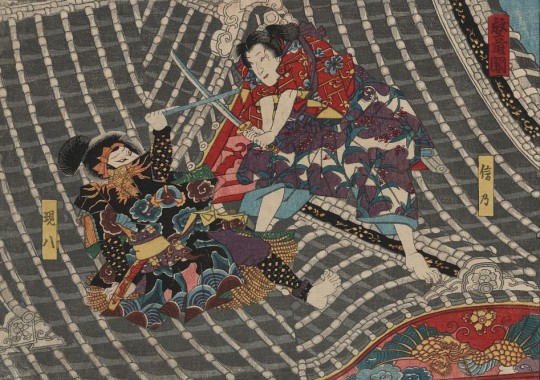
The Horyu Tower: Shino and Genpachi by Utagawa Kunisada (1851-52)
#utagawa kunisada#art#ukiyo-e#woodblock prints#fine art#19th century#19th century art#edo era#edo period#woodblock print#japanese art#japanese artist#kabuki#plays#samurai#asian art#classic art
288 notes
·
View notes
Photo

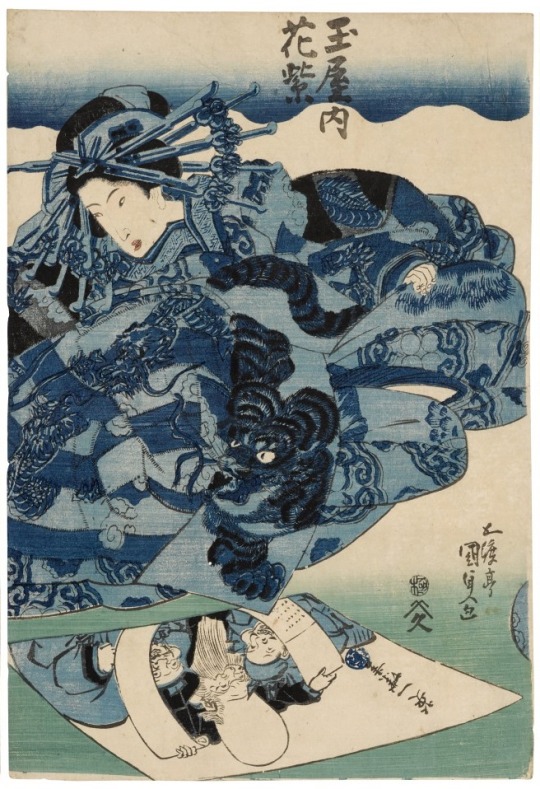

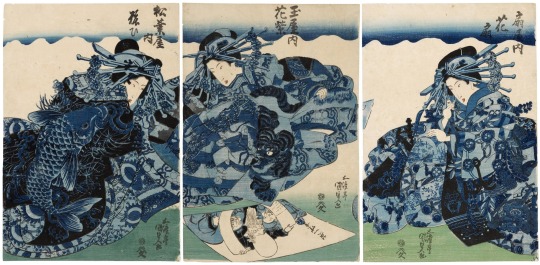
Utagawa Kunisada
Ogiya uchi Hanaogi, Tamaya uchi Hanamurasaki, Matsubaya uchi Yosoi (The courtesans Hanaogi from the Ogiya house, Hanamurasaki from the Tamaya house and Yosoi from the Matsubaya house). ca. 1830
#utagawa kunisada#art print#woodblock art#triptych#edo period#blue art#ukiyo-e#japanese beauties#traditional japanese art#aizuri#private collection
150 notes
·
View notes
Text
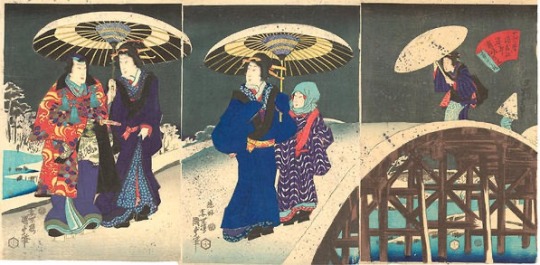

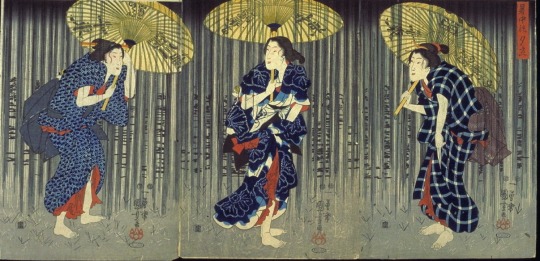
Above: Utagawa Kunisada, Genii and women on a snowy night in the Autumn at Sugatami Bridge
Center: Utagawa Hiroshige, View of Shinobazu Pond at Ueno in Snow, 1847-48
Below: Utagawa Kuniyoshi, Summer Rain (Shochu no vudashi), ca. 1850
#utagawa kunisada#utagawa hiroshige#rain#umbrellas#woodcut#nightscape#japanese prints#japanese artists#woodblock print#triptych#artists on tumblr#art history#aesthetictumblr#tumblraesthetic#tumblrpic#japanese art#tumblrpictures#tumblr art#tumblrstyle#asian art#aesthetic#japanese aesthetic
60 notes
·
View notes
Text

A Crab on the Seashore. Utagawa Kunisada (1786 – 1865)
702 notes
·
View notes
Text

Courtesans in a Yoshiwara Teahouse, 1855
by Kunisada II (1823 - 1880)
73 notes
·
View notes
Text

TOYOKUNI III (1786 - 1864): Nowaki, Chapter 28
Fifty-four Chapters of The Tale of Genji
Japanese Woodblock Print
8 3/4" x 13 1/4"
#TOYOKUNI III#utagawa kunisada#ukiyo e#color#japanese prints#japanese woodblock#i adore the use of pattern in those kimonos <3
30 notes
·
View notes
Photo


Utagawa Kunisada
Actors Nakamura Jakunosuke as Senzaki Yagorō, Ichimura Uzaemon XII as the Monster of Old Cat, Nakamura Shikan IV as Suwa Kazuemon. (with detail)
#utagawa kunisada#kunisada#japanese art#woodblock print#ukiyoe#japan#woodcut#japanese prints#printmaking#cats
294 notes
·
View notes
Text

After Bathing Beauties - Genji
Utagawa Kunisada - 1864
"Furyu Gogyo no Uchi; Suisei"
The refreshing waterfall in the summer and prince Genji.
#art#japan#japan art#waterfall#utagawa kunisada#japanese culture#japanese art#ukiyoe#woodblock#woodblock print#ukiyo e#asian art
13 notes
·
View notes
Text

Woman with a Hand Mirror from the series The Six Tama Rivers of the Floating World, c. early 1830s. Utagawa Kunisada (Japanese, 1786–1865). Color woodblock print.
#japanese#japan#japanese art#art#woman#mirror#19th century#1830s#woodblock print#japanese woodblock#utagawa kunisada
11 notes
·
View notes
Text
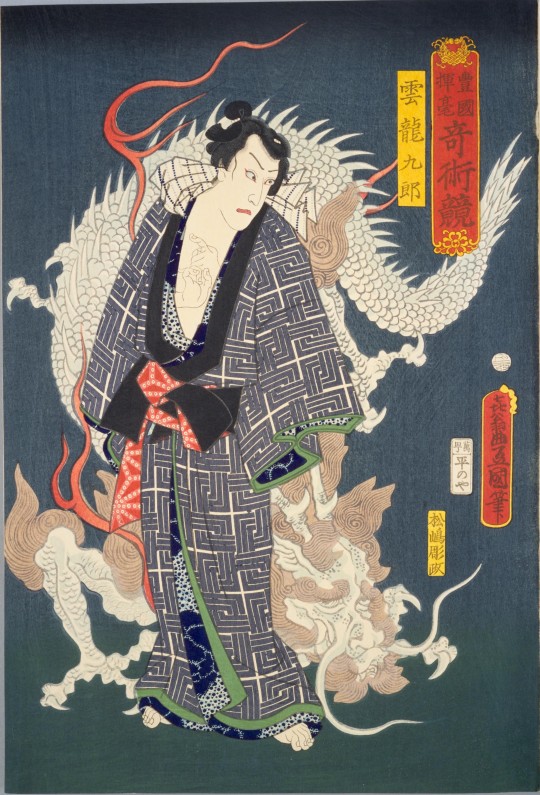
Ichikawa Danjūrō IX (from the series A Contest of Magic Scenes by Toyokuni), Utagawa Kunisada (1786-1865)
#art#art history#Asian art#Japan#Japanese art#East Asia#East Asian art#ukiyo-e#woodblock print#portrait#kabuki#Kunisada#Utagawa Kunisada#Utagawa School#Meiji period#Meiji era#19th century art#National Diet Library
85 notes
·
View notes
Photo

Landscape in the Mist, mid-19th century., mid-19th century. by Utagawa Kunisada (Undated, )
#art#artwork#kunst#kunstwerk#utagawa kunisada#asian art#asiatische kunst#landscape#landschaft#river#fluss#nature#natur#trees#bäume#mist#misty#nebel#neblig#water#wasser#art print#kunstdruck
32 notes
·
View notes